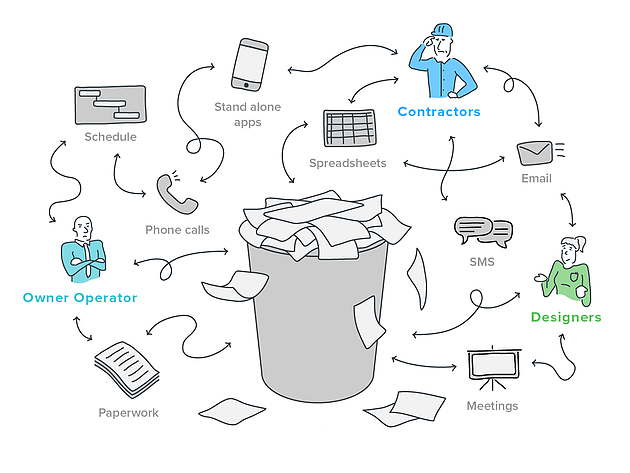Optimizing Job Partnership: Architect's Ideal Practices in Building Paper Administration
In the elaborate realm of architectural projects, the effective administration of construction documents stands as a foundation for success. Engineers, with their thorough attention to information and cutting-edge style remedies, are charged with managing a harmony of timelines, stakeholders, and sources. Nevertheless, amidst this complexity exists a crucial question: exactly how can engineers streamline partnership processes to boost task end results? By exploring crucial techniques such as leveraging cloud-based platforms, developing durable interaction protocols, and ensuring data security, architects can raise their document administration methods to new elevations.
Leveraging Cloud-Based Systems
By transitioning from typical paper-based systems to shadow services, designers can simplify collaboration, boost paper accessibility, and boost overall job effectiveness. This accessibility advertises smooth communication and control amongst task stakeholders, leading to fewer mistakes and hold-ups in the construction process.
Furthermore, cloud-based platforms provide a safe and secure setting for saving delicate job information, supplying encryption, regular backups, and customer approval setups to safeguard information stability. Designers can additionally take advantage of the scalability of cloud remedies, permitting them to adjust storage space capability and capability based upon job demands. Overall, leveraging cloud-based systems equips engineers to maximize their building and construction paper administration procedures, driving higher collaboration, performance, and success in their tasks.
Executing Version Control Solution
Having established the benefits of cloud-based systems in building and construction file management, engineers can currently enhance their document control processes by carrying out Version Control Equipment. Version Control Equipment (VCS) are vital devices that track adjustments in files, making certain that team participants are always functioning with the current and most accurate info. By executing VCS, architects can preserve a centralized repository where all job documents are saved, making it possible for smooth cooperation while lessening the threat of mistakes and variation disputes.
This feature is especially valuable in building and construction jobs where style versions and adjustments are usual. This openness not only boosts responsibility but likewise helps in settling disagreements or discrepancies that may occur throughout the job lifecycle.
Establishing Communication Protocols
To make certain effective and effective task sychronisation, architects need to develop clear and robust interaction methods within their building and construction paper monitoring procedures. This system might be a project administration software, e-mail strings, or cloud-based storage solutions.
Moreover, communication protocols ought to additionally consist of standards on just how to deal with problems, modification orders, and immediate problems that might emerge during the job lifecycle. Establishing a structured strategy to communication makes certain that all stakeholders get on the same page, promotes openness, and ultimately adds to the successful completion of the construction job.
Utilizing BIM Software for Sychronisation
BIM software plays a crucial function in boosting sychronisation amongst job their website staff member in the building and construction industry. Structure Info Modeling (BIM) helps with collaboration by providing a central system where architects, designers, professionals, and various other stakeholders can collaborate in a coordinated manner. With BIM software, project individuals can access and update a shared version which contains thorough details about the structure layout, construction elements, and job schedules.

In addition, BIM software allows real-time cooperation and interaction amongst employee, no matter their physical location. Through cloud-based BIM platforms, task stakeholders can access the newest task information, track adjustments, and make educated decisions promptly. Overall, leveraging BIM software application for coordination boosts job effectiveness, productivity, and inevitably causes effective task end results.
Ensuring Information Safety and Conformity
In the realm of building file monitoring, protecting data stability and making sure regulatory compliance are vital factors to consider for engineers and other job stakeholders. Engineers should execute robust safety and security steps to safeguard sensitive job info from unapproved access or breaches. Using safe and secure cloud storage space options with file encryption protocols and gain access to controls can help alleviate dangers related to information burglary or loss. Regularly updating software program and systems, performing safety audits, and giving personnel training on data safety and security ideal methods are important actions in preserving a safe and secure atmosphere for building and construction document management.

Conclusion
To conclude, engineers can enhance job cooperation in building and construction record administration by leveraging cloud-based systems, carrying out version control systems, establishing interaction procedures, using BIM software application for sychronisation, and making sure information security and conformity. These ideal methods aid improve the building procedure, improve communication among job stakeholders, and improve efficiency in task shipment. By following these standards, architects can effectively take care of construction files and promote effective task outcomes.
Through BIM software application, project participants can access and upgrade a shared design that consists of thorough info regarding the structure layout, construction components, and task timetables.
Through cloud-based BIM systems, project stakeholders can access the latest project details, track adjustments, and make notified decisions without delay - construction document management. Generally, leveraging BIM software application for sychronisation boosts task performance, efficiency, and inevitably leads to successful project end results
In conclusion, architects can enhance project cooperation in building and construction paper administration by leveraging cloud-based platforms, implementing version control systems, establishing interaction procedures, using BIM software program for coordination, and guaranteeing data protection and compliance. These ideal practices aid simplify the building procedure, boost interaction among task stakeholders, and boost efficiency in task delivery.